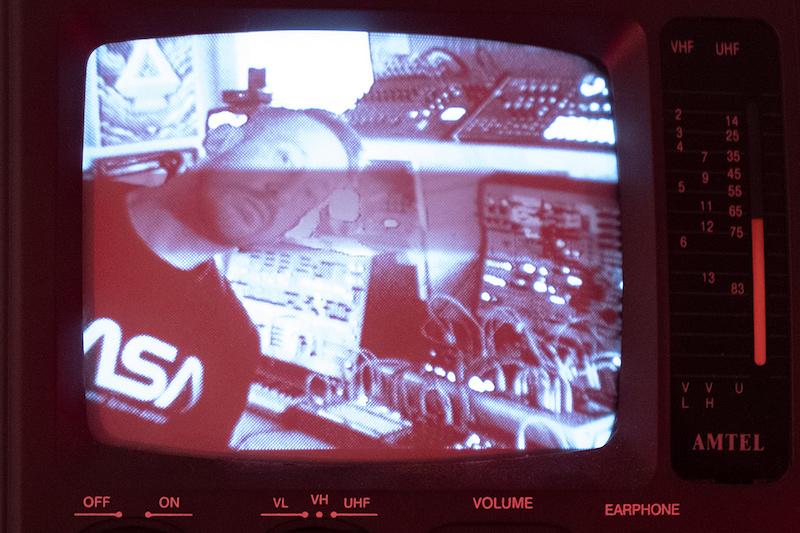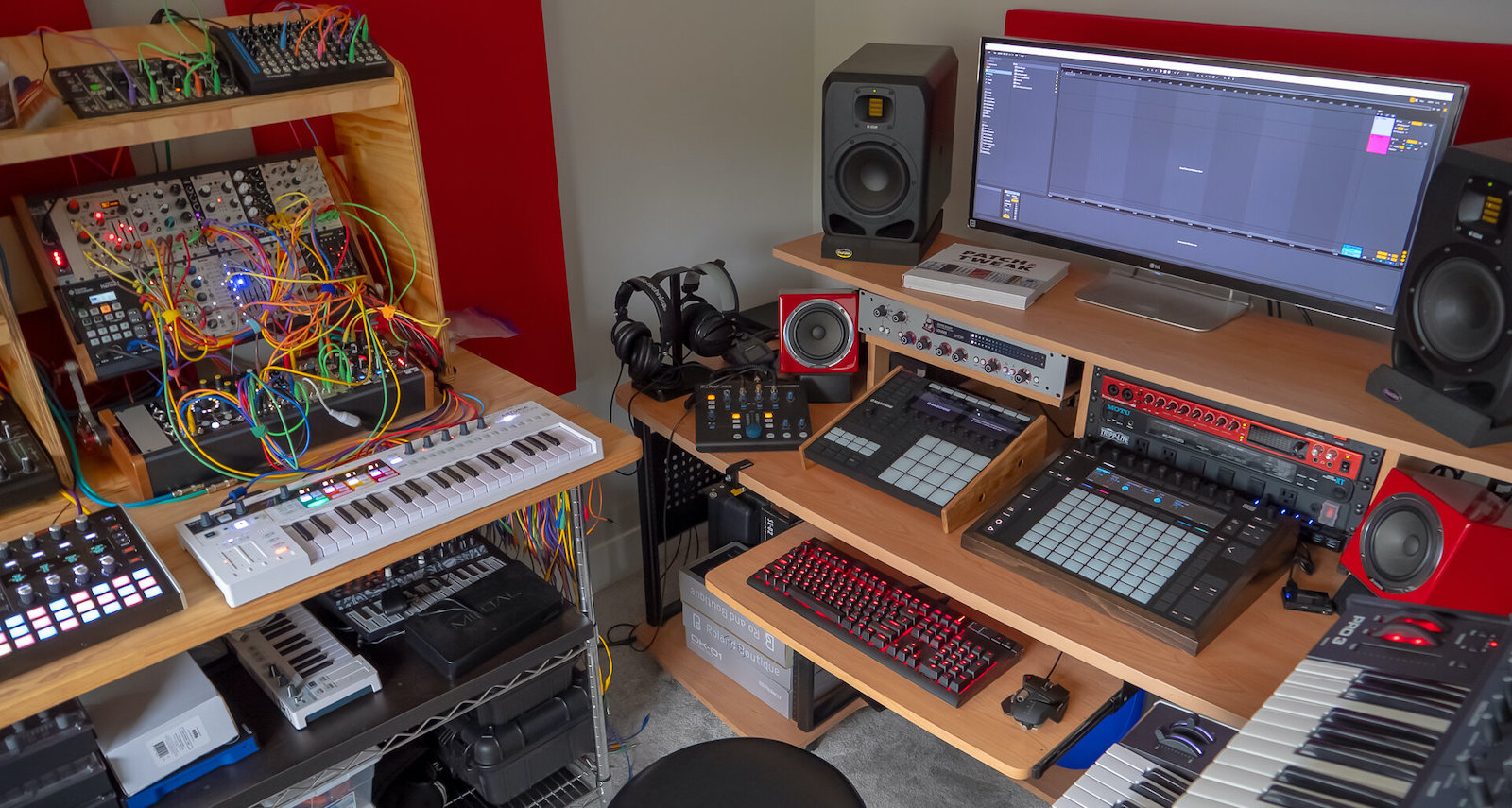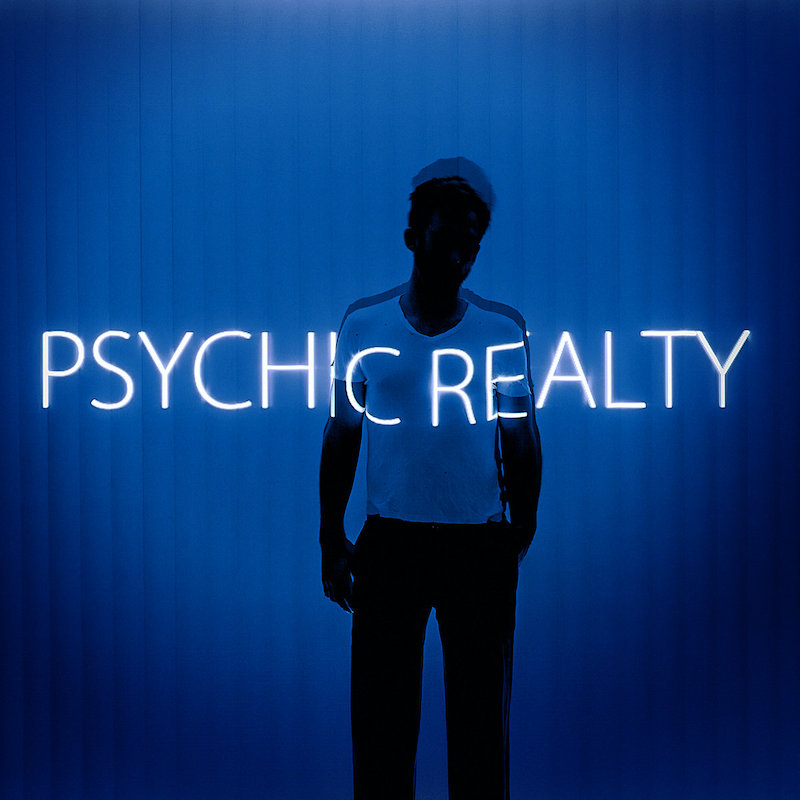If you're into electronic music production and you've ever been on YouTube, odds are that you're familiar with Jeremy Blake. He operates two spectacular YouTube channels—one channel, Red Means Recording, is dedicated to general demos/techniques/production advice, while the other, Red Means Recording Ambient focuses in on performances, techniques, and demos aimed specifically at creating lush ambient music.
Jeremy is a profoundly knowledgeable and talented musician—and as such, we've partnered with him to give away a small Eurorack modular system comprised of modules that he knows and loves. Check out our contests page for information on how you could enter to receive this system...and read on for more information about Jeremy, his music, and the system he designed for our giveaway.
An Interview with Red Means Recording: Background
Perfect Circuit: Hey Jeremy! Thanks for talking with us. I want to start with some questions about your background and then move on to talking about the system you designed for our giveaway. So to start out, how did you get into making music? Did you start immediately with electronic music? If not, how did you wind up discovering electronic music, and how did you start making your own?

Jeremy Blake (Red Means Recording): I started playing the flute in elementary school and took it all the way to my first year in college, destined to be a music performance major. Along the way, I taught myself piano on the old upright my parents had and learned about synthesizer workstations from my awesome middle school jazz band teacher, Mr. Roberts. In my senior year of High School, I was introduced to Fast Tracker II and was immediately hooked.
PC: From your perspective, how did your YouTube channel get started? We first became aware of you due to your amazing Teenage Engineering OP-1 performances and tutorials—but what inspired you to start using YouTube as an artistic/educational platform? How has it evolved since then? Do you feel like your channel has a particular mission/goal in mind?
JB: I never set out to be known on YouTube. I had been making music and DJing for decades before any of that blew up. But one day I noted a video with the OP-1 was getting a lot of views, and I decided to make more content like that. It was all very positively received, and I started getting attention from music publications like Create Digital Music and getting posted on Synthtopia, both really big things for me at the time.
With the popularity of videos where I was making music came a huge wave of questions. How did you do that? Why did you do that? I realized that people were very hungry to learn how to produce music. I started trying to work in content that explained what I could, and as I practiced explaining I was able to get deeper into conveying more complicated concepts.
As the channel grows, and as the audience asks more questions, I learn more and try to answer more. My goal with Red Means Recording in 2022 is to drill down into some specific concepts and explain them musically, technically, and historically.

PC: You're obviously a prolific creator, and have a strong presence on YouTube—but you're also putting out some amazing music. How do you balance time between your music and YouTube channel? Do you find that these parts of your practice complement one another?
JB: I make sure to take time to patch and play for myself and not the channel when I can. There’s an underlying drive to always be producing content, which is a trap, I think. In 2021 I realized that, and I want to draw back away from producing for the camera and produce a bit more for myself in 2022. The channel drives me to create, and I love that, but it also rewards a particular sort of creation over others.
PC: Many musicians develop their musical identities as players of a particular instrument—but electronic musicians often bounce back and forth between lots of different instruments/workflows. Is there a particular instrument or workflow where you generally feel most comfortable/at your musical best (and if so, what about it is so special to you)? Or does this change from day to day/project to project?
JB: My main interface with all of my gear is the musical keyboard. Flute was monophonic, and while it taught me scales and improvisation, it was the piano that led me to writing full songs. If you put a keyboard in front of me, I’ll be happy, but I also love being challenged by sequencers that force me to consider musical progression in a more esoteric way. That’s why modular has been so fun to get into.
 Cover art for Blake's album, Psychic Realty
Cover art for Blake's album, Psychic Realty
PC: How do albums usually come together for you? (i.e. Are they pieced together from live performances? Planned out ahead of time? Compiled from disparate shorter recordings?)
JB: When I first started making music, it was just whatever genre or style I liked at the time, and the albums that came out of that were collections of those. The only album I’ve written that was from front to back intended to be a cohesive work was Psychic Realty, which was my attempt at an alternative singer/songwriter album.
Since starting YouTube, my musical output has been tied to the work I do to learn and demonstrate stuff for the channel. I’ll be exploring a particular technique or setup, and music will be the result. I don’t have the luxury of time to sit and really stew on an album, so I try to make my creative output and my “business” output play nicely.
Regardless of this, there will always be an attempt to make an album release feel coherent. You pick the music that works together to give the listener a particular experience. You sequence the tracks so that they flow in a way you think is best. You consider the effect the music will have on the listener if they choose to put your album on, and from that springs a feeling, an idea. That feeling is the album, so the title and the art for the album come from that.
PC: Where are you looking for inspiration these days (in the context of music and/or your YouTube channel)?
JB: Anywhere and everywhere! I try to write down any video idea I have that sticks with me for a few days and create it when I can. As for musical inspiration, I’m listening to Jakey’s Pine Barrens on repeat right now.
PC: Do you have exciting upcoming projects you can talk about? What are you looking forward to in 2022? Where should people be looking to stay up to date on all of your projects?
JB: 2022 is going to be a year of focus and deeper exploration of musical and technical concepts. I hope to have some interesting and educational content on the main channel and more jams on the second channel.I’ll have a new iteration of my Digitakt + Digitone project (Soft Music To Do Nothing To) coming as well. Hope to see you there!
(Editor's note: Check out Jeremy's work on the Red Means Recording YouTube channel, Red Means Recording Ambient YouTube channel, on his own website, and on his Bandcamp page!)
The System: an Experimental Modular Groovebox
PC: Looking at the system you assembled for our giveaway, it resembles a sort of small modular groovebox. That thought in mind, what is inspiring to you about doing groovebox-like things with a modular synthesizer rather than a dedicated instrument? Do you see any downsides to doing groovebox-like tasks with a modular system?
JB: If I wanted a standard synthesizer, I would buy a synthesizer. Synths like the Hydrasynth, Peak, Modwave, and Pro 3 offer a level of modulation that rivals a eurorack system that would cost 5 times that. I’ve never been interested in creating a single instrument with eurorack, instead gravitating towards systems that can create full “song” experiences in a variety of genres.
The only downside to the “groovebox” aesthetic in eurorack is when you compare what you get with drum modules and sequencers vs. a dedicated drum machine. Usually it’s better to go with an external drum machine like the TR6s or Digitakt, as the sequencer, performance tools, effects, and sounds are going to be way more capable for the price.
That said, I love the VPME QD to death and would suggest it to anyone.
PC: Choosing a sequencer can (in some ways) determine a lot about the type of music a small system tends to produce, leading you to specific sorts of musical decisions. What attracted you to the combination of 6equencer, Pam's New Workout, and Vox Digitalis in the context of this small system? How do you find you're using each of these in tandem?
JB: Pamela's New Workout is less of a “sequencer” than a “brain”. It’s the backbone of clocked events in all my systems, bridging the gap between CV and MIDI (with the expander). I love that it can do easy Euclidian patterns and has the skip functionality. In this system it’s also the sole source of modulation outside the QD’s internal LFO.
Gates are some of the most important things you can have access to in a system, as they designate events actually happening in a way you want them too. The 6equencer fit well in this case, and was meant to take sequencing pressure off of Pam’s so the latter could do modulation.
Finally, the Vox Digitalis: I knew I wanted something doing deterministic pitch sequencing for the QD, as Pam’s really only does randomized pitch values (with quantization). The idea was that you could use the Vox to get pitched sequences from samples or wavetables in the QD, sample those in the Morphagene, and build up a track that way. 8 steps might not seem like a lot, but it’s surprisingly powerful.
PC: One of the striking aspects of this system is that it doesn't contain many of what someone might consider "core" synthesizer building blocks, like VCOs, filters, VCAs, etc. Is there a reason you stayed away from these typical synth components in favor of sample-based devices and the Vpme.de QD?
JB: I wanted to offer the user the most flexibility and power in a tiny case. The vpme.de QD can do synth lines with the internal wavetables and with single synth shots pitched around. I show that off in my video demos for the system. Again, this was meant to be something someone could play an entire track with, and any single attempt at a traditional voice in this system would have eaten up way too much HP.

PC: How do you generally use Morphagene in a setup like this? (i.e. Are you live sampling, or preparing samples beforehand? Are you using samples from other gear/external sounds, or samples from within the system?)
JB: Both! That’s the beauty of Morphagene. It can be used as a granular playback device for prepared samples, or you can create a reel on the fly from the QD or from an external synthesizer. In my demos for this, I have the Korg Wavestate running into it full time, sometimes just acting as a line-level pass-through, and in some cases sampling the Wavestate and making a reel on the fly. It’s very modular in how you can approach it.
PC: When compared to other granular modules (like Beads or Arbhar, for instance), what does Morphagene uniquely offer for you?
JB: I think Arbhar is an amazing granular device, and I liked Beads as an effect, but Morphagene feels very playable and performative. Here’s a few reasons:
The splice system is extremely powerful. Each “reel” can be just under 3 minutes or so. Each reel can have splice points throughout, and you can select a splice manually with the Organize knob, step through them linearly with a trigger, or traverse them with CV.
When you realize that splice points can designate any part of a piece of audio, things get very interesting. You can have a variety of complex sounds with a splice point at the beginning of each one and change the entire topology of your mix with the flick of the Organize knob. You can set up “slices” in a single piece of audio and remix it on the fly, and more. It’s very easy to back and forth in play direction to get cool tape stop effects, or repitch a sequence to fit a new key.
Finally, the “Morph” function, when turned to the extreme, generates wonderful pitched-up versions of the sound to add a layer of complexity and urgency to a mix.
PC: How do you typically find you use the Milky Way in this setup?
JB: There are a few configurations for the effect unit. You can run it as a master effect, with the Morphagene and QD both going into it. Set it to reverb for a great ambient glue, or compressor for a nice pump. You can run Morphagene or QD through it to color just one of your sound sources—or you could run the QD through it and then into Morphagene to create cool reels of affected audio.
I spend all but 1 demo in configuration 1. I love reverb. :)
PC: Most (if not all) of the modules you chose for this system are devices that we've seen you use before. But in our experience, changes of context alone can have a profound influence on how you approach even familiar tools. Did you notice anything different about your approach to these modules in the context of this specific system?
JB: Yeah! It was really interesting. The medium really is the message here, and you have to look at what each module can do and strip down the arrangements to make the best of it. I didn’t have individual voices to do basses and leads and the like, so I had to maximize the collection of samples on the QD to offer as much diversity as possible. Also, having to show off different genre approaches for the device was a lot of fun, thinking about the best way to do beat driven or ambient on it.
It may look small, but I think the system is truly mighty. I’m actually a little sad to see it go! I hope whoever ends up with it enjoys it as much as I did.















